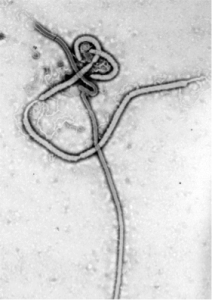Don’t let Ebola Evolve!
Posted 27th October 2014Life is a battle and most of the combatants are microbes. Bacteria, viruses, protozoa, nematodes and even microscopic fungi have slain nearly everyone or everything who has ever lived on this planet and have been doing so ever since the first microbes crawled out of the primeval mud billions of years ago. And they have gotten to be very good at their job, which is basically to get inside our body and persuade our cells to make lots and lots of copies of themselves.
That they are very good at their job can be appreciated by considering the difference in scales involved. Whereas in the macroscopic world, size matters – big animals generally eat the smaller ones – with microbes, even the tiniest agent can be deadly. A brainless virus composed of only millions of atoms can slay a highly intelligent person made of trillions upon trillions of atoms. The secrets of how tiny microbes manage to overwhelm organisms so much bigger that they is only now being unravelled by scientists who uncover the structures of viruses or the strategies that bacteria or other microbes use to invade our cells, such as the type 3 secretion systems that the plague bacillus has used to inject deadly poisons into our cells.
These structures and strategies are the product of billions of years of evolution. But their evolution hasn’t stopped. In and around 1918 a newly-evolved strain of influenza virus swept across the world and killed about 100 million people, far more than were killed in World War 1. Bacteria, such as the TB bacillus, have recently evolved resistance to nearly all of our current arsenal of antibiotics.

“T3SS needle complex” by Pixie – Own work. Licensed under Creative Commons Attribution-Share Alike 3.0 via Wikimedia Commons
And what about the Ebola virus; can it also evolve?
The West is belatedly discovering the perils of neglecting of an infectious disease problem in an obscure corner of the world. Modern travel ensures that there are no really obscure parts of the world and its only the volume or air inside a Boeing 707 that separates us from the most deadly diseases on the planet. But even more dangerous than the movement of a virus across a continent is the movement of a pathogen genome in evolutionary space. The current Ebola virus is not very infectious in humans. An infected person will usually only infect between one and two other people. Compare that to the flu where an infected person, on average, will infect about 17 people. But whilst the disease is raging in West Africa, the virus is potentially evolving. Some of the trillions of virus particles that are being passed between thousands of infected individuals will carry mutations and if some of those mutations are more infectious then they will spread more. Future strains of Ebola could become more infectious. How much more infectious? We don’t know. Could Ebola evolve the ability to be transmitted by the respiratory route, like influenza? Again, we don’t know. But do we want to risk finding out?
The only way to prevent evolution of a deadly virus is to prevent its replication. Epidemics need to be rapidly controlled, with the kind of resources that we are happy to throw at military threats. So far the resources mobilized to control Ebola around the globe amount to only about $300m. Compare that the estimated £25bn to build a new Trident Fleet to protect a single country, the UK, against a completely undefined and uncertain threat. If a tiny fraction of the world’s defence budget had, years ago, been spent on developing vaccines to those obscure diseases evolving in neglected corners of the globe then we wouldn’t be in the dangerous situation in which we now find ourselves, pretty-much defenceless to protect ourselves against one of the deadliest agents ever to have emerged on our planet.
The West needs to wake up to the reality that its biggest threat isn’t other people but other microbes.

